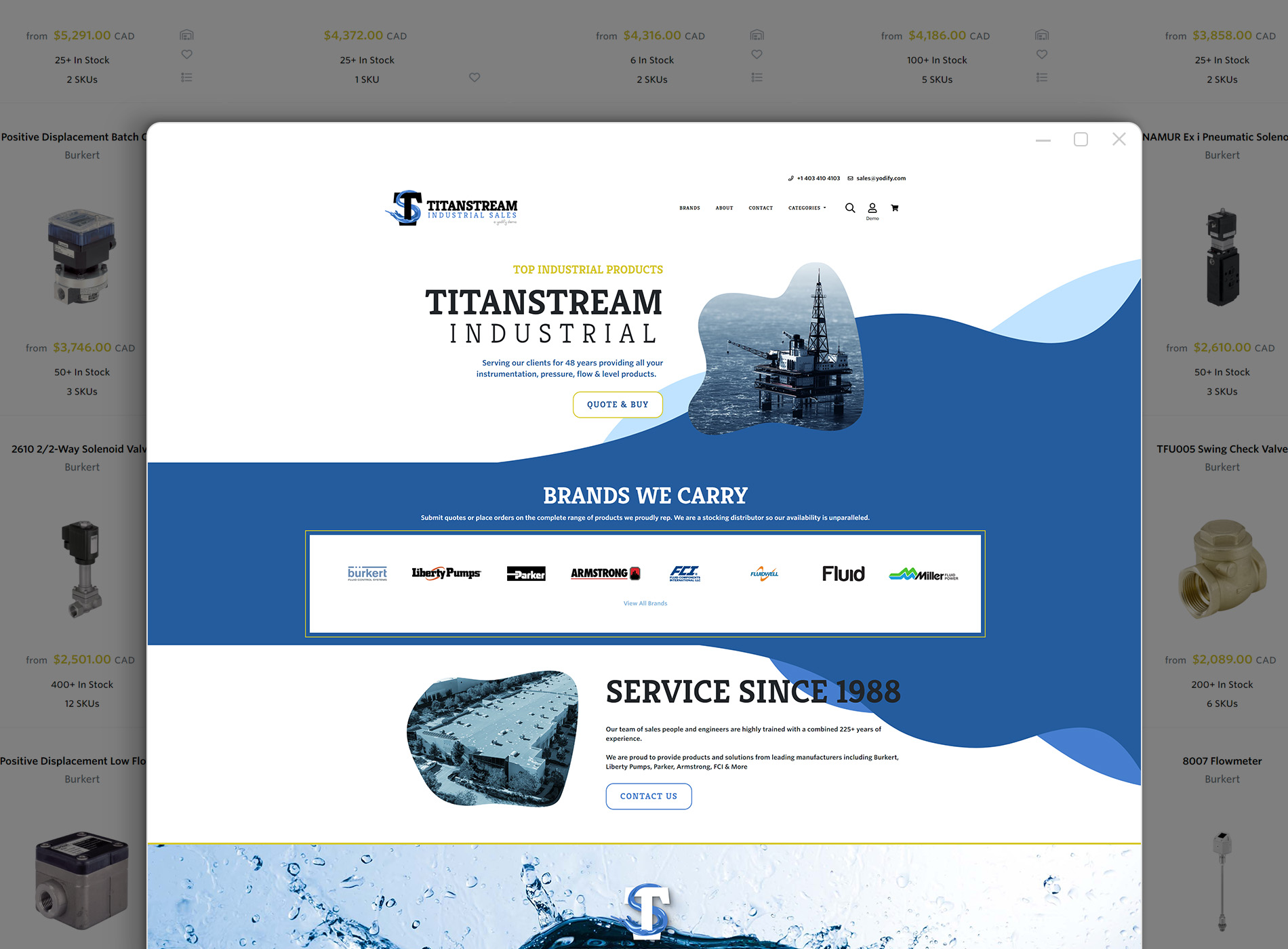Yodify Product Library
Instantly add the MINIFLASH FP Vision and 50,000+ more product series to your store or catalog
Book Your Demo and See How
or create your store
MINIFLASH FP Vision
Brand: Grabner InstrumentsThe flash point tester MINIFLASH FP Vision is uniquely designed to determine the flash points of liquids and solids.
The analyzer uses Grabner flash point detection method, which is triggered by an energy-controlled electric arc and measures instantaneous pressure increase inside a closed chamber.
By heating the test chamber from the top, the analyzer prevents condensation of high volatile compounds and guarantees improved test results.
MINIFLASH FP Vision continuously closed cup design and small sample volume of only 1-2 ml offer maximum safety.
No offensive fumes are released in the testing area and little to no sample waste is registered when performing a flash point test.
The fast thermoelectric cooling at the end of each flash point test plus the easy handling of the instrument also save expensive labor time.
MINIFLASH FP Vision is part of the Vision analyzer line. Vision analyzers support remote access to test results via the COCKPIT Software and are equipped with a full-color touchscreen.
The touchscreen of the MINIFLASH Vision features an easy-to-use graphical interface and do away with the need for training.
Any technician is capable of running a flash point test with MINIFLASH FP Vision!
As other analyzers of the Vision product line, MINIFLASH FP Vision offers hassle-free communication with USB, Ethernet, LIMS and PCs and nearly unlimited storage capacity for test results.
Grabner Instruments offers two versions of MINIFLASH FP Vision: MINIFLASH FPH Vision, for high temperatures up to 400°C, and MINIFLASH FP Vision, for temperatures between -25°C and 120°C.
The flash point testers determine flash point according to ASTM D6450 and according to the advanced ASTM D7094 standard.
This procedure describes the “Standard Test Method for Flash Point by Modified Continuously Closed Cup (MCCCFP)”, which offers the highest repeatability and reproducibility and an excellent correlation to the D93 Pensky-Martens method.
The official statement from the ASTM committee goes as follows: "there is no statistically significant bias observed between ASTM D7094 and ASTM D93 Procedure A”.
Also, ASTM D7094 has been approved by the ASTM committee for the Diesel Fuel and Kerosene specifications ASTM D975, D396, D2880 and D3699.
Test results delivered by these ASTM methods are equivalent to other well known standards such as Abel and TAG.
Additionally, thanks to the unique design of Grabner flash point analyzers, MINIFLASH FP Vision can be used for difficult applications like flash point testing of biodiesel and of contaminated samples.
Examples of contaminated samples that can be tested with the analyzer are: diesel fuel in lube oil and gasoline in diesel fuel. The MINIFLASH FP Vision analyzer includes improved methods for simulation of EN ISO 3679 and EN ISO 3680 too.
Due to true portability and rugged housing, the MINIFLASH FP Vision is the perfect solution for mobile labs and military applications.
FP(H) Vision's ejecting sample drawer allows for the easiest and safest sample cup insertion.
The open-tray design minimizes the risk of sample spillage during loading of the sample cup and keeps the operator's hands away from the oven surface, which is especially important for high temperature applications.
The New Technology
Advanced Peltier Cooling Technology
The FPH Vision is equipped with a patented cooling block that provides a high thermal contact conductance when the oven is needed to cool down between tests.
A Peltier element (thermoelectric cooling device) prepares the cooling block by cooling it before being moved into place to remove heat from the oven.
Its robust design allows the block to fully engage the oven assembly, until the oven is cooled, without risk of damage to the Peltier element.
Due to the large thermal capacity of the cooling block, the FPHV oven can be cooled-down faster than similar technologies on the market while consuming less power.
Faster cooling translates to lower measuring intervals and maximum sample throughput.
Ignition Protection Technology
FP(H) Vision’s patented ignition protection technology reduces power consumption by at least 80%, compared to previous models and similar closed cup flashpoint analyzers on the market.
The highly stable and robust ignition design, in addition to its efficiency, prevents high-power peaks and makes burning or damage to the electrodes impossible.
Combustion Analysis
Sometimes samples contain small concentrations of flammable compounds, which do not show a definite flashpoint.
MINIFLASH FP Vision detects even a very small flame and graphically shows the presence of contaminations in those samples.
In contrast, automatic explosion probing detects high concentrations of volatile components and prevents premature combustion in case of improper user programming.
Flexibility
The ability to control parameters like heat rate, ignition energy and the amount of atmospheric oxygen present in the combustion chamber let users simulate nearly any flash point method and environmental condition.
Wide Range of Applications
With Grabner flash point testers, flash points are determined over a wide temperature range, simulating all standard closed cup methods as well as GO/NOGO tests using only 1-2 ml samples.
The programmable fuel dilution curve (diesel fuel or natural gas in lubricating oil) is a powerful tool for used oil analysis to prevent costly engine troubles.
Over the last years, the outstanding performance of MINIFLASH has proven effective for transport regulations/classifications, product specifications and used oil analysis all over the world.
Principle
An aluminum cup with a capacity of 7 mL and containing 2 mL of sample is resting in the sample cup holder.
For the test, the sample cup is lifted to the temperature controlled oven, forming the test-chamber with a metal to metal seal. A thermocouple is immersed into the sample to measure the temperature.
The temperature of the oven is controlled by Peltier elements and an air cooled heat sink. The vapor is ignited by a high voltage arc inside the test-chamber.
At the flash point, the pressure inside the sealed measuring chamber is increased significantly, which is detected by a built-in pressure transducer.
A rotating magnet and a small magnet inside the the sample cup provide stirring.
Features- Flash point according to ASTM D6450/SHT0768 (Flash Point by Continuously Closed Cup) and ASTM D7094 (Flash-Point by Modified Continuously Closed Cup)
- Equivalent EN ISO 2719, excellent correlation to ASTM D56, ISO13736, IP170
- ASTM COMMITTEE STATEMENT: "There is no statistically significant bias observed between ASTM D7094 and ASTM D93 Procedure A."
- Approved for diesel fuel and kerosene specifications ASTM D975, D396, D2880, D3699
- Approved for ASTM specifications of recycled fuel and biodiesel
- New methods for EN ISO 3679 and EN ISO 3680 simulation
- Dilution Flashpoint Testing
- Go / No Go Flashpoint Testing
- Fast screening methods
- Customized screening methods for higher flexibility
- Automatic ignition cleaning method
- Ignition Protection Technology guarantees safety first and foremost
- No open flame or offensive vapors in the lab
- Highest accuracy
- Remotely operable
- Big, color touchscreen for convenient, intuitive menu navigation
- Hassle-free communication and data transfer via USB, Ethernet, LIMS and the PC software COCKPIT for Vision analyzers
- User rights management and statistical quality control with COCKPIT Software for Vision analyzers
- Worldwide standard method for the flavors and fragrances industry
- Short measuring time due to small sample volume of 1-2 ml
- Combustion Analysis
- Excellent thermoelectric heating and cooling regulation with Advanced Patented Peltier Cooling Technology
Specifications
Brand
Temperature Range - MINIFLASH FP Vision
- 0° to 120° C (32° to 248° F) without Cooling
- Down to -25° C (-13° F) with Water Cooling
Temperature Range - MINIFLASH FPH Vision
- 10° to 400° C (50° to 750° F)
Power Requirements
- 100/110/120/230/240 Vac 50/60 Hz, Max. 180 W (Optional Car Adapter for Field Use)
W x H x D
- 253 x 368 x 277 mm (10” x 14.5” x 10.9”)
Weight
- 10.2-11.2 kg (22.4 lb)
Precision Data - MINIFLASH/ASTM D6450
- Repeatability: ± 0.4° C (0.7° F)
- Reproducibility: ± 0.9° C (1.6° F)
Precision Data - MINIFLASH/ASTM D7094
- Repeatability: ± 0.5° C (0.9° F)
- Reproducibility: ± 0.9° C (1.6° F)
Precision Data - Pensky-Martens/ASTM D93A
- Repeatability: ± 4.1° C (7.4° F)
- Reproducibility: ± 6.9° C (13.4° F)
- Petrochemistry:
- Flash Point Testing of Residuals
- Fast Screening of Jet Fuel and Diesel Fuel to Check for the Presence of Contaminants with Flash Contaminants
- Advantage: High Temperature Range and Very Safe Operating Procedure
- Pharmacy:
- Flash Point Testing of Products Containing Solvents like Ethanol, IPA, Glycerol, etc
- Advantage: Small Sample Volume
- Transport:
- Flash Point Testing of Flammable Goods to Check for Compliance with Transport Safety Regulations
- Advantage: Easy Handling
- Flavors and Fragrances:
- Flash Point Testing of Aroma Products Containing Alcohol Based Solvents
- Advantage: Small Sample Volume Significantly Reduces Costs for Expensive Base Products
- Paints and Varnishes:
- Flash Point Testing of Solvent Based Paints, Varnishes and Enamels to Determine the Safest Way of Storage
- Advantage: Small Sample Volume and Easy to Clean
- Waste Disposal: Testing of Industrial Waste and Unknown Mixtures of Liquid Hydrocarbons
- Advantage: Small Sample Volume, Fast Thermoelectric Cooling in Case of Samples having a Flash Point Well Below Ambient Temperature
- Maintenance of Engines and Pumps:
- Fuel Dilution in Lube Oils Changes Oil Viscosity and hence its Lubricating Properties
- The result is Increased Friction and Wear of Mechanical Parts that can eventually Lead to Serious Damage and Engine Drop-out. Fuel Dilution decreases the Flash Point
- Advantage: Preventive Maintenance
Documentation
Application Notes/Documents
- Advances in Flashpoint Testing: Economic Impact pdf 114 KB
- Austrian Railways pdf 288 KB
- Cement Industry pdf 254 KB
- Flavors & Fragrances pdf 32 KB
- Petroleum Samples pdf 56 KB
- Pharmaceutic Waste (English) pdf 47 KB
- Pharmaceutic Waste (German) pdf 46 KB
- Procedure for Flavors pdf 49 KB
- Shipboard Dilution Testing pdf 55 KB
- Transportation Flashpoint pdf 47 KB
- Waste Determination pdf 54 KB


